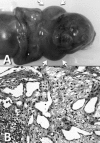Fetal nuchal cystic hygroma associated with aortic coarctation and trisomy 21: a case report
- PMID: 19918412
- PMCID: PMC2769422
- DOI: 10.4076/1757-1626-2-8280
Fetal nuchal cystic hygroma associated with aortic coarctation and trisomy 21: a case report
Abstract
We report a case of fetal nuchal cystic hygroma associated with aortic coarctation and trisomy 21. A stillborn baby, delivered at 15 weeks and 5 days of gestation, had a huge nuchal cystic hygroma. Autopsy revealed aortic coarctation of the periductal type with patent ductus arteriosus, endocardial cushion defect and left ventricular hypoplasia. Trisomy 21 was evident by karyotyping. Macroscopically, while an apparent association of nuchal cystic hygroma and aortic coarctation resembled Turner syndrome, histopathological findings were those typically seen in trisomy 21: numerous dilated lymphatics in the subcutaneous tissue with severe mesenchymal edema, and an enlarged jugular lymphatic sac.
Figures


Similar articles
-
Jugular lymphatic maldevelopment in Turner syndrome and trisomy 21: different anomalies leading to nuchal edema.Reprod Sci. 2008 Apr;15(3):295-304. doi: 10.1177/1933719107314062. Reprod Sci. 2008. PMID: 18421024
-
A case report of Turner syndrome associated with fetal nuchal cystic hygroma and bilateral syndactyly of the hands and feet.Ital J Pediatr. 2019 Jul 18;45(1):85. doi: 10.1186/s13052-019-0680-4. Ital J Pediatr. 2019. PMID: 31319890 Free PMC article.
-
Nuchal cystic hygroma associated with massive lymphangiomatosis of the upper extremity and myocardium in a stillborn fetus: a case report.Am J Cardiovasc Pathol. 1990;3(4):341-6. Am J Cardiovasc Pathol. 1990. PMID: 2151786
-
Recurrent fetal cystic hygroma with normal chromosomes: case report and review of the literature.J Matern Fetal Med. 2000 Nov-Dec;9(6):366-9. doi: 10.1002/1520-6661(200011/12)9:6<366::AID-MFM1010>3.0.CO;2-E. J Matern Fetal Med. 2000. PMID: 11243297 Review.
-
Etiology, prognosis and management of nuchal cystic hygroma: 25 new cases and literature review.Eur J Obstet Gynecol Reprod Biol. 1997 Jan;71(1):3-10. doi: 10.1016/s0301-2115(96)02590-0. Eur J Obstet Gynecol Reprod Biol. 1997. PMID: 9031953 Review.
Cited by
-
Imaging heart development using high-resolution episcopic microscopy.Curr Opin Genet Dev. 2011 Oct;21(5):573-8. doi: 10.1016/j.gde.2011.07.004. Epub 2011 Sep 4. Curr Opin Genet Dev. 2011. PMID: 21893408 Free PMC article. Review.
References
-
- Azar GB, Snijders RJ, Gosden C, Nicolaides KH. Fetal nuchal cystic hygromata: associated malformations and chromosomal defects. Fetal Diagn Ther. 1991;6:46–57. - PubMed
-
- Yoshida S, Miura K, Yamasaki K, Miura S, Shimada T, Tanigawa T, Yoshida A, Nakayama D, Masuzaki H. Does increased nuchal translucency indicate a fetal abnormality? A retrospective study to clarify the clinical significance of nuchal translucency in Japan. J Hum Genet. 2008;53:688–693. doi: 10.1007/s10038-008-0299-6. - DOI - PubMed
-
- Moselhi M, Thilaganathan B. Nuchal translucency: a marker for the antenatal diagnosis of aortic coarctation. Br J Obstet Gynaecol. 1996;103:1044–1045. - PubMed
Publication types
LinkOut - more resources
Full Text Sources

